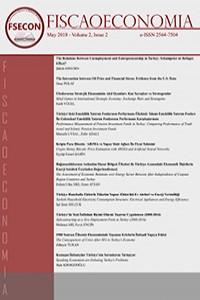Abstract
References
- 5627 Sayılı Enerji Verimliliği Kanunu.
- Bilim, Sanayi ve Teknoloji Bakanlığı. (2013), Beyaz Eşya Sektörü Raporu. Sanayi Genel Müdürlüğü Sektörel Raporlar ve Analizler Serisi.
- Ek K., Söderholm P. (2010). “The devil is in the details: Household electricity saving behavior and the role of information”. Energy Policy, Volume 38, Issue 3, 1578-1587.
- Göloğlu B., ve Akın, E. (2014), “Türkiye’de Hane Halkları Elektrik Talebininin Belirleyicileri: Sıralı Logit Yaklaşım”. Siyaset, Ekonomi ve Yönetim Araştırmaları Dergisi, Cilt:2, Sayı: 3, 1-20.
- IEA. (2014). Energy Efficiency Indicators: Fundamentals on Statistics. Paris: OECD/IEA.
- Koç Üniversitesi. (2012). Türkiye’nin Enerji Verimliliği Haritası ve Hedefler. İstanbul.
- Resmi Gazete web sayfası, www.resmigazete.gov.tr
- Özkul, M. (2011). Türkiye Ekonomisinde Beyaz Eşya Sektörünün Önemi. Ekonomik Yaklaşım, Cilt : 22, Sayı: 78, ss.119-136.
- TESİD. (2014). Elektronik Sanayi Almanağı, http://www.tesid.org.tr/tsd/ttPage.asp?pageID=200.
- TMMOB. (2012). Türkiye’nin Enerji Görünümü: Oda Raporu. Makine Mühendisleri Odası, MMO/588, Ankara
- Türkiye Cumhuriyeti Başbakanlık Yatırım Destek Ve Tanıtım Ajansı. (2010). Türkiye Beyaz Eşya ve Elektronik Sektörü Raporu, http://www.iso.org.tr/Sites/1/upload/files/BEYAZ.ESYA.ELEKTRONIK.SEKTORU_INVEST-469.pdf (erişim: 23.10.2014)
- Tewathia N. (2014). “Determinants of the Household Electricity Consumption: A Case Study of Delhi.”, International Journal of Energy Economics and Policy, Vol:4, No: 3, 337-348.
- Türkiye İstatistik Kurumu. (2003-2012). Hanehalkı Bütçe Anketi Ham Veri Seti, Ankara, TÜİK.
- Yüksek Planlama Kurulu. (2012). Enerji Verimliliği Strateji Belgesi 2012-2023. 28215 sayılı Resmi Gazete
- Vassileva I., Wallin F., Dahlquist E. (2012). “Analytical comparison between electricity consumption and behavioral characteristics of Swedish households in rented apartments.” Applied Energy, Volume 90, Issue 1, 2012, 182-188.
Abstract
Turkey’s electricity demand has been increasing following the trends of the world. One of the main elements making up this demand is the households which immediately follows the industrial sector in the consumption order. Investigating the electricity consumption trends of the electrical appliances, especially considering increased energy costs, energy security issues and environmental impacts of energy use, is important to implement more realistic and effective policies. Majority of electricity used in houses is consumed by electrical and electronic goods. For this purpose, households' electricity consumption tendencies were taken into consideration by using the household budget surveys of TURKSTAT and especially the use of electrical household appliances was examined because the households had an important place in electricity consumption. It is also thought that the findings of the article will help the future of energy policies.
References
- 5627 Sayılı Enerji Verimliliği Kanunu.
- Bilim, Sanayi ve Teknoloji Bakanlığı. (2013), Beyaz Eşya Sektörü Raporu. Sanayi Genel Müdürlüğü Sektörel Raporlar ve Analizler Serisi.
- Ek K., Söderholm P. (2010). “The devil is in the details: Household electricity saving behavior and the role of information”. Energy Policy, Volume 38, Issue 3, 1578-1587.
- Göloğlu B., ve Akın, E. (2014), “Türkiye’de Hane Halkları Elektrik Talebininin Belirleyicileri: Sıralı Logit Yaklaşım”. Siyaset, Ekonomi ve Yönetim Araştırmaları Dergisi, Cilt:2, Sayı: 3, 1-20.
- IEA. (2014). Energy Efficiency Indicators: Fundamentals on Statistics. Paris: OECD/IEA.
- Koç Üniversitesi. (2012). Türkiye’nin Enerji Verimliliği Haritası ve Hedefler. İstanbul.
- Resmi Gazete web sayfası, www.resmigazete.gov.tr
- Özkul, M. (2011). Türkiye Ekonomisinde Beyaz Eşya Sektörünün Önemi. Ekonomik Yaklaşım, Cilt : 22, Sayı: 78, ss.119-136.
- TESİD. (2014). Elektronik Sanayi Almanağı, http://www.tesid.org.tr/tsd/ttPage.asp?pageID=200.
- TMMOB. (2012). Türkiye’nin Enerji Görünümü: Oda Raporu. Makine Mühendisleri Odası, MMO/588, Ankara
- Türkiye Cumhuriyeti Başbakanlık Yatırım Destek Ve Tanıtım Ajansı. (2010). Türkiye Beyaz Eşya ve Elektronik Sektörü Raporu, http://www.iso.org.tr/Sites/1/upload/files/BEYAZ.ESYA.ELEKTRONIK.SEKTORU_INVEST-469.pdf (erişim: 23.10.2014)
- Tewathia N. (2014). “Determinants of the Household Electricity Consumption: A Case Study of Delhi.”, International Journal of Energy Economics and Policy, Vol:4, No: 3, 337-348.
- Türkiye İstatistik Kurumu. (2003-2012). Hanehalkı Bütçe Anketi Ham Veri Seti, Ankara, TÜİK.
- Yüksek Planlama Kurulu. (2012). Enerji Verimliliği Strateji Belgesi 2012-2023. 28215 sayılı Resmi Gazete
- Vassileva I., Wallin F., Dahlquist E. (2012). “Analytical comparison between electricity consumption and behavioral characteristics of Swedish households in rented apartments.” Applied Energy, Volume 90, Issue 1, 2012, 182-188.
Details
| Primary Language | English |
|---|---|
| Subjects | Business Administration |
| Journal Section | Articles |
| Authors | |
| Publication Date | May 31, 2018 |
| Published in Issue | Year 2018 Volume: 2 Issue: 2 |



